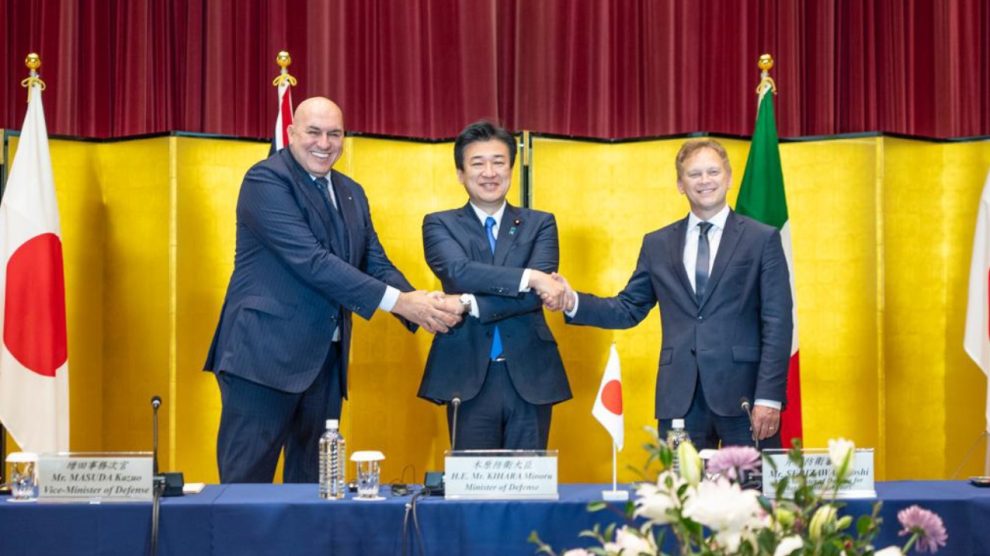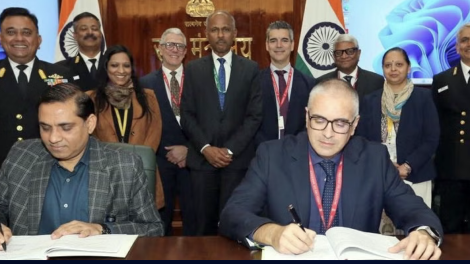The GCAP is a go. As we anticipated, Italy, the United Kingdom and Japan have signed an international agreement to establish the Global Combat Air Programme, their shared project to develop a sixth-generation fighter jet. The deal was penned in Tokyo by the defence ministers of the three countries – Italy’s Guido Crosetto, Britain’s Grant Shapps and Japan’s Minoru Kihara – on Thursday. It must now be ratified by the three national parliaments.
- “For the first time, Italy will also participate with equal dignity (33%) in a programme of this magnitude,” reads a note from the Ministry of Defence, recalling that the only comparable programme – the Eurofighter – saw Rome as a 22% partner, much lower than London.
How it began. A year ago, the heads of government of the three countries – Italy’s Giorgia Meloni, the UK’s Rishi Sunak and Japan’s Fumio Kishida – announced the merger of the research carried out by Japan on the F-X jet and by Italy and the United Kingdom on the Tempest. That agreement embodied the concept that “Euro-Atlantic and Indo-Pacific security are indivisible,” as PM Sunak had commented.
- At the time, the three governments had agreed to jointly develop a next-generation air combat platform by 2035, emphasising in a joint memo their commitment to uphold “the rules-based, free and open international order.”
- They stressed that defence of the democratic worldview requires strong defence and security partnerships, underpinned and strengthened by a credible deterrent capability.
The details. The headquarters of both the institutional GCAP project and its industrial counterpart will be based in the UK. The first CEO of the government division will hail from Japan, while the first CEO of the industry organisation will be from Italy. Under the supervision of the coordinating body, a consortium made up of the Italian aerospace company Leonardo, Japan’s Mitsubishi Heavy Industries and the UK’s BAE Systems aims to complete the design of the new aircraft by 2027.
What they said. The agreement marked a “very important milestone” for the GCAP project and a “powerful message to the rest of the world,” said Minister Crosetto regarding the trilateral partnership. “We are living in a very complex era, characterised by aggressive actors on the international stage – a situation of growing instability, competition between States and rapid technological change. It has therefore become essential to stay one step ahead of the threats that are growing every day.”
- “Our three nations have a long-standing relationship based on the same values of democracy and freedom, respect for human rights and the rule of law. Through GCAP, we have been able to further develop and strengthen our relationship in the field of defence,” he noted.
- His Ministry aims to spend €7.7 billion on the project in the 2023-2025 period, a steep rise from the 2022 estimates of €3.8 billion.
- “Our world-leading combat aircraft programme aims to be crucial to global security, and we continue to make hugely positive progress toward delivery of the new jets to our respective air forces in 2035,” remarked Minister Shapps.
- According to the British government, the supersonic stealth jet will boast a powerful radar that can provide 10,000 times more data than current systems, giving a battle-winning advantage.
Dominating the skies. GCAP-born jets are intended to replace roughly 90 Japanese F-2 fighters and over 200 British and Italian Eurofighters. The project envisages the development of an integrated air combat system in which the main platform, the human-controlled aircraft itself, is the central node of a network of remotely piloted aircraft with different roles and tasks, ranging from reconnaissance to combat support, which can multiply the effectiveness of the system itself.
- The whole capability package will then be inserted into the all-domain dimension, as it will be capable of communicating effectively and in real-time with other military assets on land, at sea, in the air, in space and in cyberspace.
- This integration will allow the jet to be designed from the outset to coordinate with all other deployable military assets, enabling decision-makers to have a complete and constantly updated picture of the theatre of operations, with a multiplier effect on scenario analysis capabilities and decision options in response to changing events.
Who’s in from Italy. The post-meeting official note from the Italian Ministry of Defence highlights the expected deliverables: attaining the operational advantage to face the challenges of new scenarios by developing a “system of systems”, technological and industrial sovereignty, and prosperity. At the industrial level, in Italy, the programme is led by Leonardo IT, in collaboration with MBDA IT, Elettronica and Avio Aero, with the aim of establishing a wider collaborative process involving leading companies as well as small and medium-sized enterprises, research centres and universities, “thus creating a network of competences capable of bringing together national excellence in both the industrial and academic spheres.”
- The GCAP “will generate innovative technologies with significant spin-offs in terms of employment, skills and know-how for the entire national industrial ecosystem,” the note concludes.





